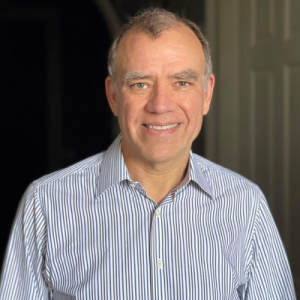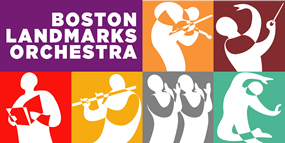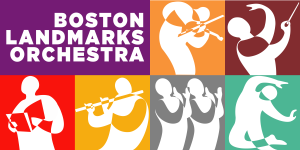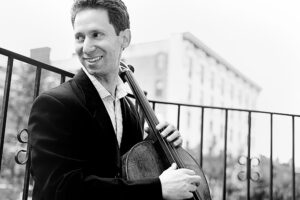by Christopher Wilkins
The second concert of the Boston Landmarks Orchestra’s series at the Hatch Shell is on Saturday, August 3. By tradition, we perform on Wednesdays because there are fewer conflicts during the week than on weekends. On the other hand, some believe that Saturdays can draw bigger crowds. And others would rather avoid a “school night.” So, for the past few years, we’ve done some of each. We welcome your thoughts, as always. We’re gathering evidence as we go!
In planning a Landmarks season, we consider people first, program second. To represent the cultures of as many Bostonians as possible, we begin by thinking about the people who write, perform, attend, and collaborate in the music we perform. This approach isn’t unique to the Landmarks Orchestra by any means, but I believe we’re unusual in that for us, it’s pretty much the whole game.
This summer, we focus on orchestral music rooted in folk song. Folk songs represent individual cultures in a way that art songs cannot. An art song is by a person; a folk song is by a people.
Popular music was central to Johannes Brahms’s early career. His concert tours, with Brahms at the piano, accompanying the flashy 25-year-old Hungarian violinist, Eduard Reményi, featured arrangements of folk dances based on verbunkos, or czardas, or gypsy dances. Twenty-seven years later, he again quoted popular songs in his Academic Festival Overture, a thank-you to the University of Breslau for awarding him an honorary doctorate. The work is an ingenious tribute to the tradition of German student songs, AKA beer-hall tunes. It boasts four boisterous tunes as if for sport, all the while maintaining the “decorum” of a serious concert work.
Brahms was a master of balance. Here, he balances classical rigor and popular appeal—the “academic” and the “festival.” The overture overflows with warmth and good humor—irreverence even—and yet it is brilliantly unified by sonata form in the tradition of a classical overture. The work culminates in a full-throated rendition of “Gaudeamus igitur,” the centuries-old drinking song that remains a favorite of universities and sports teams to this day. Brahms’s setting almost invites an audience sing-along:
Gaudeamus igitur,
Iuvenes dum sumus!
Post iucundam iuventutem
Post molestam senectutem
Nos habebit humus. |
So, let us rejoice
While we are young.
After a pleasant youth
After a troublesome old age
The earth will have us.
|
Brahms’s concert works incorporating popular music are direct descendants of Liszt’s Hungarian Rhapsodies. These symphonic potpourris spawned a whole genre of engaging works based on folk song and dance. Boston Landmarks Orchestra has performed many of them in recent seasons, including Enesco’s Romanian Rhapsody, Chabrier’s España, and Arturo Márquez’s Danzón No. 2. Now we can add to the list Hugo Alfvén’s Swedish Rhapsody No. 1 (Midsummer Vigil).
Alfvén was a gifted watercolorist. Alfvéngården—Alfvén’s last home, now owned by the Swedish Royal Academy of Music and preserved as a museum—houses many of his paintings. A visual quality pervades Alfvén’s music. It revels in tone color and scene painting. His popular Swedish Rhapsody No. 1 intertwines myriad images of a carefree summer day: a folk singer accompanied by Swedish lute; the spinning of a whirligig; swirling leaves; a melancholy shepherd’s song; and a country dance at a peasant wedding.
Canadian American composer Joel Hoffman is the son of the late conductor Irwin Hoffman, long associated with the Chicago Symphony and an early protégé of Serge Koussevitsky. Joel was born in Vancouver, BC, when his father was music director of that city’s orchestra. Joel‘s music draws from the traditions of many cultures, including Eastern European folk music, Chinese traditional music, and American bebop. He composed Self-Portrait with Gebirtig in 1998 for his cellist brother, Gary Hoffman. Tonight’s soloist is the Orchestra’s brilliant principal cellist, Aron Zelkowicz.
The composer writes:
“[The] title refers to the fact that three of the principal melodies of the piece (one from each of the three movements) were originally composed by Mordechai Gebirtig, a modest but celebrated Jewish folk musician who lived in Krakow, Poland and died at the hands of the Nazis in 1942.
“These three melodies are interwoven with original melodic material and presented in the context of a compact concerto for cello and chamber orchestra. There are many moments throughout the piece in which the sounds of a traditional klezmer band are alluded to. The overall character, however, is that of an elaboration, an expansion of these ideas well beyond what one might expect from an “authentic” presentation of Gebirtig’s melodies. And this is where the “self-portrait” aspect emerges: since I have been involved in various projects of performing Gebirtig’s music as part of the Alpert Hoffman Trio (as pianist and arranger), I allowed Gebirtig’s melodies in this case to work their magic on my imagination—to help me dream about what a “klezmer cello concerto” might have been like.
“For those who would like to know the specific references, the Gebirtig melodies I used are: “Ker Bezemel Ker” in the first movement; “Bay Gvirim” in the second; and “Azelche Zwej Goldene Zep” in the third. Other melodies you might hear—like the principal tune of the second movement, “Sabbath Queen”—I will have to take full responsibility for!”
Tonight, we give the first public performance of three spirituals arranged decades ago by Julia Perry. A Black woman who grew up in Akron, Ohio in the late 30s and early 40s, Perry enjoyed tremendous early success. She was a “five-tool player”: composer, pianist, violinist, singer, and conductor. She received exceptional training in the public schools in Akron, at the Westminster Choir College in Princeton, NJ, and at the Juilliard School. An important early break came when she won a scholarship to Tanglewood, where she met Aaron
Copland and her future mentor, Luigi Dallapiccola. Perry was eventually admitted to the class of Nadia Boulanger—teacher of Copland, Astor Piazzolla, Quincy Jones, and so many others—where she earned the top prize in composition. Perry enjoyed tremendous success while living in Italy, especially for her Stabat Mater, for which she often sang the mezzo-soprano solo. When she returned to the United States, she found that doors were not open to her as they had been in Europe, a depressingly familiar story. Her health deteriorated, she suffered a series of debilitating strokes, and died penniless in Akron at the age of 55.
Julia Perry arranged spirituals throughout her life, beginning with vocal and choral settings she published with major houses while still in her twenties. She arranged two sets of spirituals for orchestra alone: Three Spirituals (c. 1956) and Four Spirituals (c. 1965). Both sets will be published within the year as part of a new arrangement with the Estate of Julia A. Perry. The Akron Symphony held a private reading of Three Spirituals in the spring of 2022, a recording of which will be released later this year.
Like most of Perry’s music, Three Spirituals is compact in form and concise in style. It has no flourishes or grand gestures. It lasts about five minutes. The first movement is a setting of “Roll, Jordan, Roll,” the first of the one hundred and thirty-six songs published in the groundbreaking compilation, Slave Songs of the United States (A. Simpson & Co., New York, 1867). The spiritual that forms the basis of the second movement has still not been identified. The final movement is an arrangement of “Dere’s No Hidin’ Place Down Dere,” a song made famous by Marian Anderson through her 1938 recording released on the Victor label.
Dvořák occasionally quoted folk melodies. But he was so steeped in the traditions of his native Bohemia that his music often sounds like folk music even when it is not. His Eighth Symphony is a case in point. It opens with an expansive and singable melody in G minor for cellos, with dark shading in clarinets, bassoon, and horns. The tune eventually alights on a sunny major chord, as a separate theme springs up in the flute. There is a new vitality now, as if someone has opened a window. Soon the mood shifts again, and the strings begin a rhythmically charged crescendo. A dramatic flourish in the timpani brings this paragraph to a close, and the lower strings—still in G major—launch yet another theme. Is this, at long last, the main subject? Or was the main subject the opening cello melody, or perhaps the flute theme? A calm now settles in the strings, and an attractive dance tune springs up in the woodwinds—the fifth independent tune to appear in just a few minutes of music.
The form of the symphony is recognizably sonata form, but the profusion of themes gives the music an improvisatory quality. It’s as if Dvořák’s head was so full of ideas that he couldn’t limit himself to the usual two or three main themes per movement, as most composers do, but treats us to one fresh idea after another. It was the astounding ease with which he created melodies that so impressed Brahms—and made him more than a little envious.
The second movement is a scene in the country. Its open-air ambience rises out of the soil of Dvorak’s beloved Bohemia. With the third movement, Dvořák again writes music half in G minor and half in G major. It begins with a sad, lilting waltz. A sweetly beguiling tune in flute and oboe form the middle section. After the opening waltz returns, a burst of adrenaline converts the flute-oboe melody into a rousing Coda.
Dvořák’s finale begins with a rousing fanfare for two trumpets in unison. The timpanist echoes their rhythm to set up a sweetly nostalgic two-part theme in the cellos. The movement comprises a set of variations on this memorable tune, but the form is a hybrid: variations and sonata form combined. The symphony’s good nature, its tunefulness, and its tendency to break into dance at any moment, are part of the national character. As Czech conductor Rafael Kubelik put it during a rehearsal of the last movement’s opening fanfare: “In Bohemia, the trumpets never call to battle. They always call to the dance.”
 CHRISTOPHER WILKINS was appointed Music Director of the Boston Landmarks Orchestra in the spring of 2011. Since then, he has expanded the orchestra’s mission of making great music accessible to the whole community. He has also helped develop the orchestra’s Breaking Down Barriers initiative, making accessibility a priority in all aspects of the orchestra’s activities.
CHRISTOPHER WILKINS was appointed Music Director of the Boston Landmarks Orchestra in the spring of 2011. Since then, he has expanded the orchestra’s mission of making great music accessible to the whole community. He has also helped develop the orchestra’s Breaking Down Barriers initiative, making accessibility a priority in all aspects of the orchestra’s activities.

